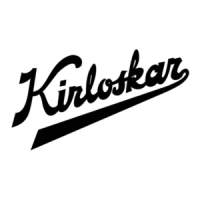23
This is a proprietary document of Kirloskar Brothers Limited, Kirloskarvadi-416308, Dist-Sangli (India)
ISSUE DATE: 17.09.2010 LAST REV. DATE:
PIPING
Both suction and delivery pipes and accessories should be independently supported near the pump, so
that when the flanges, bolts are tightened no strains will be transmitted to the pump casing. It is
usually advisable to increase the size of both the suction and delivery pipe at the pump nozzles in
order to decrease the loss of head due to friction and for the same reason piping should be arranged
with minimum possible bends as possible, or it should be made with long radius wherever possible.
The pipe lines should be free from scales, welding residuals etc., and have to be mounted in such a
way that they can be connected to suction and delivery flanges without any stress on the pump. It can
be achieved by supporting the pipelines at appropriate locations.
SUCTION PIPE
The suction pipe should be as short as possible. This can be achieved by placing the pump near the
liquid to be pumped. The suction pipe must be kept free from air leakages. This is particularly
important when the suction lift is high. A horizontal suction line must have a gradual rise to the pump.
Any high point in the pipe will be filled with air and thus prevent proper operation of the pocket in
the top of the reducer and the pipe. Use an eccentric piece instead.
The end of the suction pipe must be well submerged to avoid whirlpools and ingress of air but must
be kept clear of any deposits of mud, silt grit etc. The pipe must be away from any side of the wall by
450 mm. the end of the strainer must be provided with a strainer of sufficient open area.
DELIVERY PIPE
A check (non return) valve and a gate of sluice valve (regulating valve) should be installed in the
discharge line. The check valve placed between the pump and the gate valve is to protect the pump
from excessive pressure and to prevent water running back through the pump in case of failure of the
driving machine.
Discharge piping should be provided with a sluice valve adjacent to the delivery flange to control the
discharge if required.
VACUUM EQUALIZING LINE (AND LIQUID LINE)
If the pump draws from a system under vacuum an equalizing pipe must be carried from the highest
point of the suction line, however as close to the suction flange of the pump as possible, to the top of
the feed tank to keep gas bubbles that might have been entrapped in the flow from entering the pump.
The line should be fitted with an isolating valve which should be closed only for maintenance work
on the pumpset. Apply sealing liquid (external sealing) to the shaft seal cage to prevent entry of air in
the case of the pumps with packed stuffing box. It is convenient to tap the sealing liquid from the
delivery line above the non-return valve.
FOOT-VALVE
It is advisable to install a foot-valve to facilitate priming. The foot-valve should have sufficient clear
passage for water. Care must be taken to prevent foreign matter from being drawn in to the pump or
chocking the foot-valve and for this purpose an efficient strainer should be provided.
STUFFING BOXES AND PACKING (only for gland packed pump)
Stuffing boxes should be carefully cleaned and packing placed in them. Be sure that sufficient
packing is placed at the back of the water seal cage. If the water to be pumped is dirty or gritty,
sealing water should be piped to the stuffing boxes from clean outside source of supply in order to
prevent damage to the packing and shaft. In placing the packing, each packing ring should be cut to
the proper length so that ends come together but don’t overlap. The succeeding rings of packing
should not be pressed too tight, as it may result in burning the packing and cutting the shaft. If the

